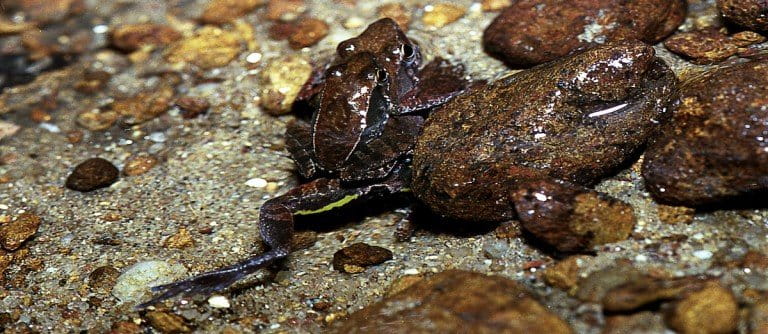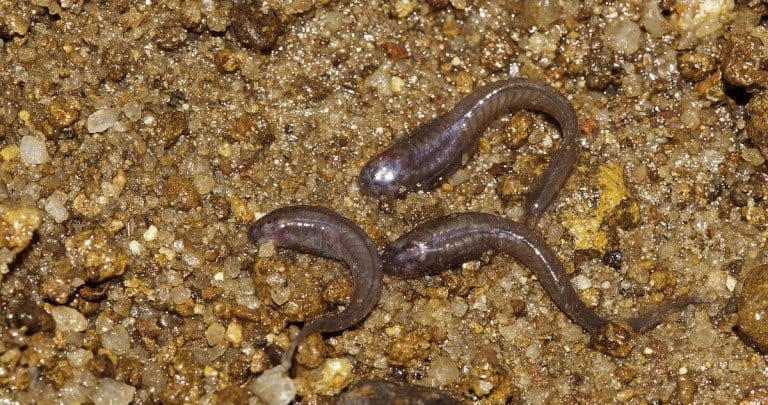- Dancing frogs of the Micrixalidae family (named for their unusual courtship behavior) are endemic to India’s Western Ghats.
- For years, no one could find Micrixalidae tadpoles, making them the only unknown tadpoles of any known frog family.
- Then, finally, researchers discovered them – living underground.
In the mountainous rainforests of India’s Western Ghats lives a unique family of dancing frogs. Now, scientists have discovered they have yet another surprising distinction – their tadpoles live underground.
The Western Ghats is a tropical mountain chain that lines the southwest coast of the Indian subcontinent. The region is something of a hotbed of diversity when it comes to amphibians: it boasts many endemic species found nowhere else in the world, with new species frequently uncovered in its thick and rugged forests.
The individual responsible for many of these discoveries is amphibian biologist Sathyabhama Das Biju, who has earned the nickname “Frogman of India” due to his prolific achievements. For instance, in 2015 Biju and his team rediscovered a tree frog species in northern India whose tadpoles eat their mothers’ eggs, and in 2014 he headed up an expedition that led to the discovery of 14 new species of dancing frogs.
Unlike most other frog species, dancing frogs of the family Micrixalidae don’t vocalize to attract mates. They live in fast-flowing streams that would drown out any croaking or ribbiting. Instead, they wave their legs to attract mates, flashing their feet to signal their breeding prowess.

For his latest research, published yesterday in PLOS ONE, Biju went back to dancing frogs — specifically, the mystery surrounding their early stages of life. You see, no one had ever seen their tadpoles in the wild (well, no one who recorded it in a scientific publication), which meant Micrixalidae was the last known frog family in the world whose tadpoles remained unknown.
Since a tadpole is essentially the aquatic stage of a frog’s life (though some frogs remain aquatic in adulthood), it makes sense to look for them in the water. This is especially true when the adults conduct their mating behaviors in and around water sources, as dancing frogs do. And so, for many years, Biju and his colleagues looked for dancing frog tadpoles in the streams where they found adults. But they didn’t have any luck (except for a single tadpole Biju found in 2004).
Then he and his team started looking more closely at dancing frog mating behavior.
“Subsequently, over the years we made several observations of females of this species laying eggs in cavities that they dug (with their own legs) in streambeds covered with shallow water,” Biju told Mongabay. “This was a clue, and we conducted dedicated surveys at the same locality in the months of January and February 2012. We focused our searches on the streambeds, first in shallow waters, and then gradually towards sand and gravel beds on the edges of forest streams.
“They were right there, under sand and gravel beds. We found the tadpoles once we knew where to look for them!”
The tadpoles they found were from the Kaller dancing frog (Micrixalus herrei), a spritely little brown frog with a burnt umber back reminiscent of a dried autumn leaf. The tadpoles themselves are dark purplish-brown and eel-like. They have several adaptations for life underground, including tiny, skin-covered eyes on the tops of their heads and well-developed muscles for moving around in the sediment at depths of 10 to 40 centimeters (4 to 16 inches).





But what do underground tadpoles eat? Biju and his colleagues found sand mixed with sediment in their guts, indicating that they subsist off of nutrients in the same substrate they live in. While the researchers have yet to study the complete life cycle of M. herrei, Biju speculates that its tadpoles probably spend 30 to 35 days underground before metamorphosing into adults.
Unlike their dancing abilities, underground tadpoles aren’t unique to Micrixalus frogs – though they are very rare.
“Only a few fossorial tadpoles are known worldwide, from five distantly related frog families, and a lot more needs to studied about their adaptations,” Biju said.
The thick wilderness of the Western Ghats may seem removed from India’s booming human populace, but threats are mounting for its amphibians (as well as many other animals and plants). The chytrid fungus, a pathogen scientists think is responsible for the extinctions of several frog species and seep reductions in many others, was detected in remote mountain streams in the state of Karnataka in 2014. And the encroachment of cities and farmland is whittling away forest and polluting streams.
Seven of the 24 known dancing frog species live entirely outside protected areas, leaving conservationists worried about their future prospects. But Biju is hopeful that as more becomes known about this unique frog family, more will be done to protect them.
“Documenting this biodiversity is the first step towards conservation,” Biju said in a previous interview with Mongabay. “First we have to know what we need to conserve. Discovering new species increases our knowledge of what we have and their status. People are now talking about frogs. I think the change is coming and hopefully it will affect conservation policies, too.”
Citation:
- Senevirathne G, Garg S, Kerney R, Meegaskumbura M, Biju SD (2016) Unearthing the Fossorial Tadpoles of the Indian Dancing Frog Family Micrixalidae. PLoS ONE 11(3): e0151781. doi:10.1371/journal.pone.0151781